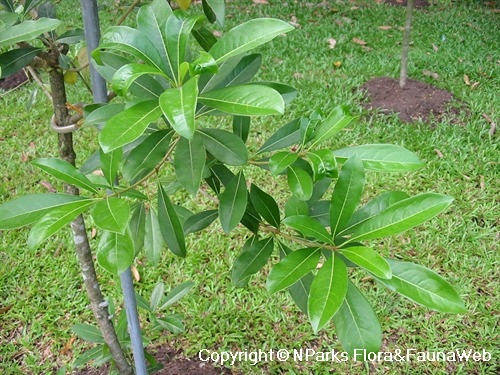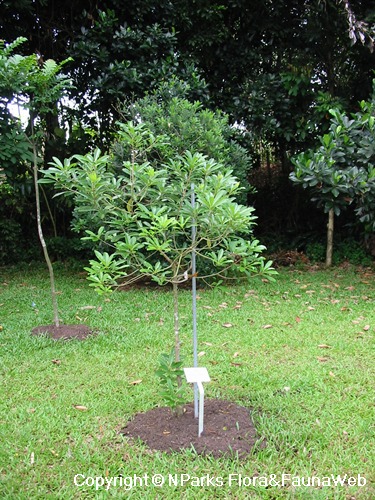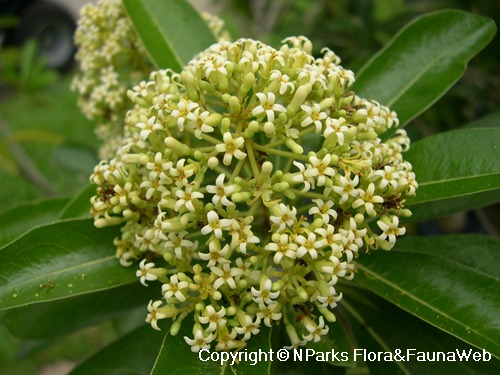
Back
Pittosporum ferrugineum W.T.Aiton
| Family Name: | Pittosporaceae |
Pittosporum ferrugineum is a small to medium sized tree that can grow to 20 m tall. It has aromatic, narrowly elliptic to obovate leaves with a tapering pointed tip. Flowers are fragrant, cream coloured, 5-petalled, clustered in an inflorescence near the ends of branches, amongst the foliage. The fruit is a capsule with wide, lobed to fluted base that turns orange and spilt open upon maturity to reveal brick red seeds coated in resins.
Name
Classifications and Characteristics
| Plant Division | Angiosperms (Flowering Seed Plants) (Dicotyledon) |
|---|---|
| Plant Growth Form | Tree (Medium (16m-30m)) |
| Lifespan (in Singapore) | Perennial |
| Mode of Nutrition | Autotrophic |
| Maximum Height | 20 m |
Biogeography
| Native Distribution | Eastern Indonesia to Papua New Guinea, Australia (Northern Territory and Queensland) |
|---|---|
| Native Habitat | Terrestrial (Monsoon Forest, Coastal Forest) |
| Preferred Climate Zone | Tropical |
| Local Conservation Status | Non-native |
Description and Ethnobotany
| Growth Form | It is a small to medium sized tree that can grow to 20 m tall. |
|---|---|
| Foliage | Leaves are thin, membranous to leathery, narrow elliptic to slightly spoon-shaped, downturned measuring 8 - 11.5 cm long by 3.5 - 5.5 cm wide with a tapering, pointed tip and wavy leaf margin. New shoots and leaves are covered in golden brown hairs. Short velvety hairs may still be present on the underside of mature foliage. |
| Flowers | Flowers are either unisexual where male flowers are held on the separate individual or bisexual. Held on an inflorescence, flowers are clustered near the ends of the branches, amongst the foliage. They are fragrant, cream coloured, star-shaped with 5 recurved petals measuring about 6 mm long. |
| Fruit | The fruit is an aromatic capsule with a wide, lobed to fluted base measuring about 10 mm long clustered in groups. Upon maturity, the capsule turn from green to orange, spilt open to reveal its brick red seeds coated in resin. |
| Habitat | In coastal scrub or open grassy woodland. |
| Cultivation | It can be propagated by seed, tolerable to salt spray. <1,2,3> |
| Etymology | Greek pitta, tar, sporos, seed, referring to the resinous coating around the seed. Latin ferrugineum, rusty-brown in colour, referring to the short, rusty-brown hairs that cover the leaves. |
Landscaping Features
| Landscaping | It is suitable for streetscapes, parks and gardens. |
|---|---|
| Desirable Plant Features | Fragrant |
| Landscape Uses | Coastal, Suitable for Roadsides, Parks & Gardens, Small Gardens, Beachfront / Shoreline, Riverine |
Fauna, Pollination and Dispersal
| Pollination Method(s) | Biotic (Fauna) (Insects (Butterfly, Moth)) |
|---|---|
| Seed or Spore Dispersal | Biotic (Fauna) |
Plant Care and Propagation
| Light Preference | Full Sun, Semi-Shade |
|---|---|
| Water Preference | Moderate Water |
| Plant Growth Rate | Moderate |
| Rootzone Tolerance | Moist Soils, Well-Drained Soils, Fertile Loamy Soils, Saline Soils / Salt Spray |
| Propagation Method | Seed |
Foliar
| Foliage Retention | Evergreen |
|---|---|
| Mature Foliage Colour(s) | Green |
| Mature Foliage Texture(s) | Velvety / Furry / Tomentose |
| Foliar Type | Simple / Unifoliate |
| Foliar Arrangement Along Stem | Alternate, Whorled |
| Foliar Attachment to Stem | Petiolate |
| Foliar Shape(s) | Non-Palm Foliage (Elliptical, Obovate) |
| Foliar Venation | Pinnate / Net |
| Foliar Margin | Entire |
| Foliar Apex - Tip | Acuminate, Acute |
| Foliar Base | Cuneate, Attenuate |
| Leaf Area Index (LAI) for Green Plot Ratio | 3.0 (Tree - Intermediate Canopy) |
Floral (Angiosperm)
| Flower & Plant Sexuality | Unisexual & Bisexual Flowers(Sub-dioecious) , Dioecious |
| Flower Colour(s) | Cream / Off-White |
|---|
| Flower Grouping | Cluster / Inflorescence |
| Flower Location | Terminal |
| Flower Symmetry | Radial |
| Flowering Habit | Polycarpic |
Fruit, Seed and Spore
| Mature Fruit Colour(s) | Orange |
|---|---|
| Fruit Classification | Simple Fruit |
| Fruit Type | Dehiscent Dry Fruit , Capsule |
| Mature Seed Colour(s) | Red |
References
| References | <1> Cayzer, L.W. & Chandler, G.T. (2017). Pittosporum tinifolium A. Cunn.: a corrected name and reinstatement at species level for the Queensland species currently known as the rusty-leaved pittosporum, Pittosporum ferrugineum subspecies linifolium (A.Cunn.) L.Cayzer et al. (Pittosporaceae). Austrobaileya 10(1): 205-206. <2> Cayzer, L.W. & Chandler, G.T. (2018). Pittosporum ridleyi (Pittosporaceae), a new name for the ‘rusty-leaved’ pittosporum in Malaysia. Garden's Bulletin Singapore 70(2): 397-404. <3> Cayzer, L.W. & Crisp, M.D & Telford, I.R.H.T. (2000). Revision of Pittosporum (Pittosporaceae) in Australia. Australian Systematic Botany 13: 888-889. |
|---|
Image Repository
Others
| Master ID | 1774 |
|---|---|
| Species ID | 3067 |
| Flora Disclaimer | The information in this website has been compiled from reliable sources, such as reference works on medicinal plants. It is not a substitute for medical advice or treatment and NParks does not purport to provide any medical advice. Readers should always consult his/her physician before using or consuming a plant for medicinal purposes. |



